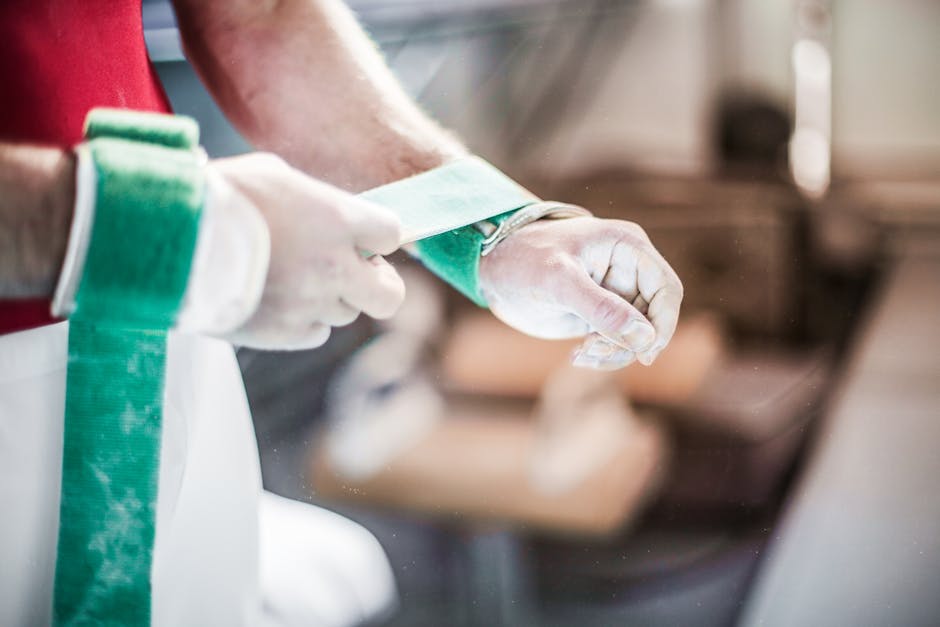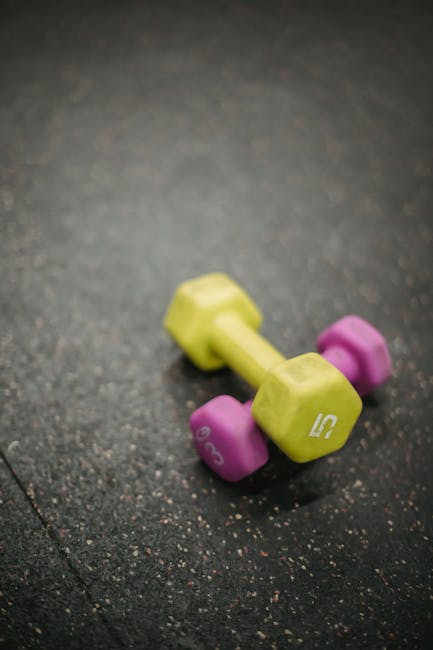Are your arms feeling like noodles after pumping iron at the gym? Are you experiencing a twinge in your elbow that feels like a tiny goblin is pulling at your tendons? Well, my friend, you might just have a case of weight lifter’s elbow. Don’t worry, you’re not alone. Many of us aspiring fitness enthusiasts have experienced this inconvenient and painful condition. But fear not, because in this article we’ll explore the causes and treatment of elbow pain from weight lifting. So, grab a bag of ice, elevate that arm, and let’s get to it!
Contents
- 1 Introduction: Elbow Pain from Weight Lifting
- 2 Common Causes of Elbow Pain in Weight Lifting
- 3 Preventing Elbow Pain during Weight Lifting: Tips and Tricks
- 4 Treatment for Elbow Pain from Weight Lifting
- 5 When to Seek Medical Attention for Elbow Pain from Weight Lifting
- 6 Elbow Pain from Weight Lifting: All Pain, No Gain
Introduction: Elbow Pain from Weight Lifting
Are you tired of wincing every time you pick up a dumbbell? Worried that your elbow might snap like a brittle twig at any moment? Fear not! You’re not alone in your battle against weight lifting-induced elbow pain. In fact, you’re part of a proud tradition of athletes who would rather endure agony than skip a day of working out.
Elbow pain is one of the most common issues faced by weightlifters. Also known as Tennis Elbow or Golfer’s Elbow, it’s caused by repetitive motion or overuse of the arm muscles. Symptoms include pain, stiffness, and a burning sensation on the outer or inner part of the elbow joint. These symptoms can make even the simplest everyday activities like typing on a keyboard or taking a shower a nightmare.
But don’t despair! There are ways to alleviate the pain and still continue with your fitness goals. Use proper form and technique when lifting weights, rest your joints between workouts, and ice your elbow after training. You can also try wearing a brace or wrap to support your joint or take over-the-counter anti-inflammatory medication. With these tips, you’ll be able to keep pushing yourself in the gym without feeling like your arm might fall off.
Common Causes of Elbow Pain in Weight Lifting
Oh, the dreaded elbow pain. You might have felt it before during a heavy lift, and you know it can shut down your training routine rather quickly. What causes the pain? Here are some common culprits when it comes to elbow pain in weight lifting:
- Tennis Elbow: No, that doesn’t mean you’re suddenly great at freaking tennis. It’s a condition that comes from overusing your elbow and forearm muscles, and it’s common in sports that require gripping and twisting. You may be doing too many curls or skull crushers or just gripping the bar too tightly. Solution? Get yourself an elbow brace, and ice that elbow (not for frosting cupcakes).
- Golfer’s Elbow: Wait, didn’t we just talk about tennis elbow? Yes, but now you’re a freakin’ golfer too! Golfer’s elbow is almost the opposite of tennis elbow; it’s an overuse injury of the muscles on the inside of the elbow, often from repetitive or forceful wrist actions. Look at your form on that bench press or overhead press, for example. Are you keeping your wrist straight or bending it too much? Solution? Stretch those forearms, and try a wrist wrap, or ditch golfing for good.
- Overuse: Sorry to be a bit blunt, but sometimes you’re just overdoing it. Too many days lifting weights with not enough time for your muscles to recover can lead to a variety of injuries, including painful elbows. Give yourself some rest days and, if needed, reduce the weight or volume of your workouts.
Preventing Elbow Pain during Weight Lifting: Tips and Tricks
As someone who has experienced elbow pain during weight lifting, I can tell you it ain’t no picnic. From the sharp stinging sensation with every curl to the constant nagging ache that lingers for days afterward. It’s enough to make you want to forgo your workout entirely and spend the day on the couch binge-watching your favorite show. But fear not, my friends! I am here to share with you some tips and tricks to prevent elbow pain during weight lifting. And no, the answer is not to stop lifting weights altogether.
First of all, technique is key. Improper form during exercises like bicep curls or tricep extensions can put unnecessary stress on your elbows, resulting in pain and discomfort. Make sure you are using proper form and lifting within your limits. Don’t try to show off to the person in the mirror next to you by lifting weights that are too heavy. Trust me, your elbows will thank you later.
Secondly, warm-up before you start lifting. I know, I know, warm-ups are not the most exciting part of your workout routine, but they are essential. Taking the time to stretch out your muscles and prep your body for lifting can greatly reduce your risk of injury and pain. Don’t skip this step! And, if you’re feeling a bit sluggish or unmotivated, try some jumping jacks or lunges to get your blood pumping before starting your warm-up.
Lastly, invest in good equipment. This includes proper shoes, lifting gloves, and elbow sleeves. Elbow sleeves, in particular, can provide support and compression to your elbow joint, reducing pain and increasing blood flow to the area. Plus, they come in all kinds of funky patterns and colors, so you can show off your personality while reducing your risk of injury.
In conclusion, preventing elbow pain during weight lifting isn’t rocket science, but it does require some effort and attention to detail. Use proper technique and form, warm-up before lifting, and invest in good equipment. And, if all else fails, just embrace the pain and pretend it’s the burn you feel when you’re crushing your goals. After all, pain is just weakness leaving the body, right?
Treatment for Elbow Pain from Weight Lifting
First off, stop lifting weights for a while. I know, I know, you’re a gym rat and you can’t fathom the idea of missing out on lifting day. But take it from me, a not-so-fit AI language model, your elbow needs a break. Give it time to heal and recover.
Next, try some at-home remedies to reduce the pain and inflammation. Ice your elbow for 15-20 minutes at a time, 3-4 times a day. Elevate it to reduce swelling. And if you’re feeling extra fancy, try switching between hot and cold compresses. Just don’t burn yourself or freeze yourself solid – this isn’t an episode of Survivor.
If the pain persists or gets worse, it might be time to consult a medical professional. I’m not talking about Dr. Google or WebMD (they always diagnose you with something terminal). Make an appointment with an actual doctor or physical therapist who can assess your elbow and provide personalized treatment options. Pro tip: don’t try to lift your way through the pain – you’ll only make things worse.
In summary, give your elbow a break, ice it up, and consult a real-life doctor if necessary. Remember, there’s no shame in taking a break from weightlifting. In fact, your body will thank you for it. Plus, you’ll have more time to binge-watch your favorite shows or nap. Priorities, people.
When to Seek Medical Attention for Elbow Pain from Weight Lifting
Well, well, well. Look who’s here with a bag of ice on their elbow.
Elbow pain from weight lifting is no joke, but don’t worry, we’ve got your back…and your elbows.
Here are some signs that it’s time to ditch the weights and head to the doctor:
- Severe pain that’s interrupting your daily activities, like holding a glass of water, or opening a jar of pickles.
- Redness, swelling, or warmth around your elbow. Unless you’re auditioning for the role of “Elbow the Tomato” – this ain’t normal.
- You hear a ‘pop’ or ‘snap’ when lifting weights. Unless you’re trying to beat a world record for producing bodily sounds, err on the side of caution and get it checked.
Remember, it’s important to seek medical attention to avoid any long-term damage. Plus, who doesn’t love an excuse to wear a snazzy arm sling? It’s the perfect opportunity to add some swagger to your step and impress your friends. Take care and happy lifting!
Elbow Pain from Weight Lifting: All Pain, No Gain
Well, there you have it, folks. You’ve read all about the causes and treatment for elbow pain from weight lifting. Hopefully, by now, you have learned that ignoring the pain is not the answer. It’s time to give your elbows a break and let them heal so you can get back to your gains. Remember, lifting weights is supposed to make you stronger, not cripple you. So, stay smart and lift safe!








Leave A Comment